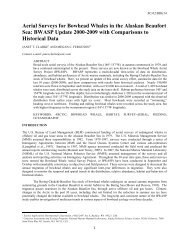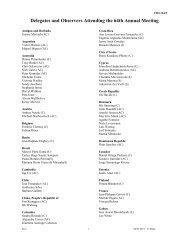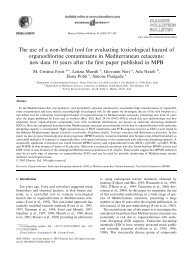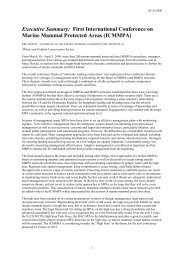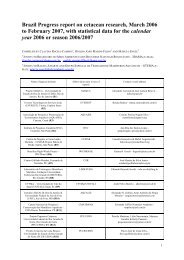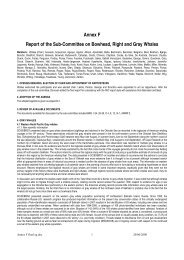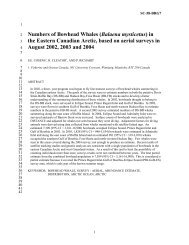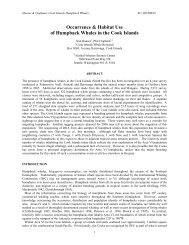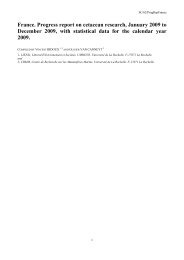Annex F - Home page of the International Whaling Commission
Annex F - Home page of the International Whaling Commission
Annex F - Home page of the International Whaling Commission
Create successful ePaper yourself
Turn your PDF publications into a flip-book with our unique Google optimized e-Paper software.
ANNUAL REPORT OF THE INTERNATIONAL WHALING COMMISSION 2007 95estimate that up to 10% <strong>of</strong> <strong>the</strong> stock could be comprised <strong>of</strong>‘stinky’ whales. This phenomenon has also been noticed in<strong>the</strong> meat <strong>of</strong> ringed and Bearded seals, walruses, and cod,and in <strong>the</strong> eggs <strong>of</strong> murres. Those who have eaten ‘stinky’meat have reported a number <strong>of</strong> short term medicalproblems including <strong>the</strong> numbing <strong>of</strong> oral cavities, skinrashes and stomach aches. No long term effects have beenrecorded.The Russian Federation noted that <strong>the</strong> reason for <strong>the</strong>strong medicinal odour is unclear. The odour wassometimes detected in <strong>the</strong> blow <strong>of</strong> <strong>the</strong> whale, at o<strong>the</strong>r timesit would not be noticed until heat was applied in cooking.Two hypo<strong>the</strong>ses have been put forward as reasons for <strong>the</strong>smell:(1) <strong>the</strong> presence <strong>of</strong> ketones, aldehydes and alcohols as aresult <strong>of</strong> a change <strong>of</strong> diet; and(2) <strong>the</strong> presence <strong>of</strong> a specific bacteria, fungus and/orbiotoxin.The Russian Federation reported that it is unclearwhe<strong>the</strong>r <strong>the</strong>re is a hereditary factor, whe<strong>the</strong>r <strong>the</strong> odourdisappears after <strong>the</strong> winter or whe<strong>the</strong>r <strong>the</strong> smell is linked toa change in <strong>the</strong> gray whale diet. It has been observed byhunters that ‘stinky’ whales have seaweed and arctic cod in<strong>the</strong>ir stomachs which is uncharacteristic.Due to <strong>the</strong> uncertainty over <strong>the</strong> issue <strong>of</strong> ‘stinky’ whales<strong>the</strong> Russian Federation requested two considerations to bediscussed at next years’ meeting to improve managementoptions. Firstly, <strong>the</strong> need for a definition in <strong>the</strong> Schedulefor ‘stinky’ whales; secondly a need for a proposal for howto account for ‘stinky’ whales that are landed but inediblefor <strong>the</strong> hunting communities.The USA introduced a joint USA/Russian Federationpaper on toxicology studies <strong>of</strong> ‘stinky’ whales(IWC/59/CC15). The approach has been to collect samplesfrom ‘stinky’ and ‘non-stinky’ gray whales and to submit<strong>the</strong>m to several laboratories for analysis <strong>of</strong> <strong>the</strong>following: persistent organochlorines (OCs); polyaromatichydrocarbons (PAHs); heavy metals; stable isotopes andvolatile organic compounds (VOCs). The objective was tocompare chemical concentrations <strong>of</strong> ‘stinky’ and ‘nonstinky’whale tissues for obvious differences to provideleads for fur<strong>the</strong>r investigation into <strong>the</strong> cause <strong>of</strong> <strong>the</strong><strong>of</strong>fensive odour. Over 2003, 2004, 2005 and 2006 samplesfrom ‘stinky’ and ‘non-stinky’ whales have been collectedand analysed by laboratories in <strong>the</strong> USA and <strong>the</strong> RussianFederation. Results <strong>of</strong> chemical analyses from <strong>the</strong> Russianlaboratory have been reviewed by Japanese and Norwegiantoxicologists. In addition to this effort, <strong>the</strong> USA andMexico have initiated a pilot project to evaluate <strong>the</strong>composition <strong>of</strong> gray whale breath in Eastern North Pacificgray whales in <strong>the</strong> breeding lagoons <strong>of</strong> Mexico forcomparison with <strong>the</strong> samples taken in <strong>the</strong> Russian hunts.Based on <strong>the</strong> samples evaluated so far, few differenceswere noted between <strong>the</strong> chemical compositions <strong>of</strong> ‘stinky’whale tissues and ‘non-stinky’ whale tissues using OC,PAH and lipid analysis. Some PCB and DDT levels werefound to be similar. Trace elements and stable isotopes in‘stinky’ whale samples were not different to those found in‘non-stinky’ whales. There were no detectable PAHs foundin samples taken in <strong>the</strong> USA laboratories, but lowconcentrations were found in <strong>the</strong> samples analysed by <strong>the</strong>Russian laboratories. Blubber lipid percentage in ‘stinky’whales was similar to that in ‘non-stinky’ whales.Volatile organic compounds caused <strong>the</strong> most intriguingresults with more than a hundred volatile compounds beingdetected in <strong>the</strong> tissues <strong>of</strong> <strong>the</strong> whales. However some <strong>of</strong> <strong>the</strong>compounds could have been as <strong>the</strong> result <strong>of</strong> repeatedfreezing <strong>of</strong> <strong>the</strong> samples or o<strong>the</strong>r handling issues.The determination <strong>of</strong> what is responsible for <strong>the</strong> ‘stinky’odour from gray whale tissues is not as conclusive aswould be desired. No single chemical compound or processhas been identified as being responsible and <strong>the</strong> results donot indicate an obvious anthropogenic source. Fur<strong>the</strong>rmore,<strong>the</strong>re is no information available to determine whe<strong>the</strong>r <strong>the</strong>‘stinky’ whale condition is indicative <strong>of</strong> a negativepopulation effect. The USA noted that it would beinformative to ensure that any fur<strong>the</strong>r ‘stinky’ whaleinvestigations are co-ordinated to evaluate environmentalchange and gray whale populations. To date <strong>the</strong>re is nodirect evidence <strong>of</strong> long-term health consequences <strong>of</strong> <strong>the</strong>consumption <strong>of</strong> ‘stinky’ whale meat.Committee discussions and recommendationsMexico thanked <strong>the</strong> USA and <strong>the</strong> Russian Federation for<strong>the</strong> reports and believed that <strong>of</strong> <strong>the</strong> two hypo<strong>the</strong>ses, <strong>the</strong> firstcould be discarded due to <strong>the</strong> presence <strong>of</strong> this phenomenonappearing in o<strong>the</strong>r marine mammals. It considered that <strong>the</strong>second hypo<strong>the</strong>sis is <strong>the</strong> most likely and that it should bepursued through increased sampling. In responding to aquestion from Belgium, <strong>the</strong> USA confirmed that <strong>the</strong>phenomenon had not been recorded in <strong>the</strong> western NorthPacific gray whale, but had in o<strong>the</strong>r marine mammals andfish.In response to a question from <strong>the</strong> UK, <strong>the</strong> RussianFederation confirmed that when a stinky odour wasdetected <strong>the</strong>n <strong>the</strong> entire animal was discarded. This is inline with Russian Federation law. Even so, it noted that <strong>the</strong>meat from stinky whales is inedible, even as dog food. Onresponding to a question from Sweden on <strong>the</strong> stomachcontent <strong>of</strong> <strong>the</strong> stinky whales and <strong>the</strong> high levels <strong>of</strong> seaweedfound, <strong>the</strong> Russian Federation confirmed that <strong>the</strong>re hadbeen no statistical analysis to compare with <strong>the</strong> level <strong>of</strong>seaweed found in non-stinky whales, although it wasthought to be in small quantities. Fur<strong>the</strong>r research would beundertaken on this. South Africa noted that this problemrelated to top predators and that it would be useful toinvestigate whe<strong>the</strong>r it applied to lower trophic levels also.4.1.2 Ship strikesThe Chair noted that in addition to <strong>the</strong> Second ProgressReport from <strong>the</strong> Ship Strikes Working Group(IWC/59/CC3), Australia and <strong>the</strong> USA had submitteddocuments relating to ship strikes. A relevant extract from<strong>the</strong> report <strong>of</strong> <strong>the</strong> Scientific Committee was also available.He suggested that <strong>the</strong> papers be dealt with first.NATIONAL REPORTSThe USA introduced IWC/59/CC11 and explained that<strong>the</strong>re were only 300 individuals left in <strong>the</strong> population <strong>of</strong>North Atlantic right whales and that ship strikes are <strong>the</strong>greatest threat to this population. The USA outlined anumber <strong>of</strong> current and proposed efforts to mitigate <strong>the</strong>effects <strong>of</strong> shipping on this population, including realigning<strong>the</strong> traffic separation scheme serving Boston. This isexpected to reduce right whale ship collisions by 58% in<strong>the</strong> area.The USA also noted that recommended shipping routeshave been established in key aggregation areas for rightwhales <strong>of</strong>f Cape Cod and <strong>of</strong>f three ports in Georgia and
96FIFTY-NINTH ANNUAL MEETING, ANNEX FFlorida. Speed advisories recommending speeds <strong>of</strong> 10knots or less are also issued to mariners in areas and attimes where right whales occur. These advice bulletins arebroadcast via wea<strong>the</strong>r radio reports, Mandatory ShipReporting Systems, <strong>the</strong> US coastguard broadcast tomariners and o<strong>the</strong>r media. Fur<strong>the</strong>r to this <strong>the</strong>re areproposals to regulate shipping speed on <strong>the</strong> US East coastin areas where relatively high right whale and shipdensities overlap and <strong>the</strong> US is developing a proposal tosubmit to <strong>the</strong> <strong>International</strong> Maritime Organisation todevelop ‘areas to be avoided’ in critical right whale habitat.The USA reported that it has developed a multi-mediaguide entitled ‘The Prudent Mariner’s Guide to RightWhale Protection’ that is intended for mariners attendingtraining at maritime academies across <strong>the</strong> US East Coast.This CD was made available to <strong>the</strong> ConservationCommittee. In addition to <strong>the</strong>se initiatives, <strong>the</strong> USA notedthat <strong>the</strong>re are ongoing aircraft surveys and right whalealerts and a Mandatory Ship Reporting System.Spain outlined two significant steps that have beenundertaken to avoid ship strikes; <strong>the</strong> separation <strong>of</strong> <strong>the</strong>traffic scheme due to high risk <strong>of</strong> collision and a notice tomariners in <strong>the</strong> Strait <strong>of</strong> Gibraltar to be radioed in <strong>the</strong> area.The aim is to raise awareness <strong>of</strong> <strong>the</strong> risk <strong>of</strong> ship strikes,encourage caution and reduce shipping speed to
ANNUAL REPORT OF THE INTERNATIONAL WHALING COMMISSION 2007 97Brazil requested that <strong>the</strong> management <strong>of</strong> whalewatchingbe included as a regular item on <strong>the</strong> Committee’s agenda,recognising that whalewatching has its own challenges andimpacts. It noted that scientific aspects <strong>of</strong> whalewatchinghave been addressed by <strong>the</strong> Scientific Committee for anumber <strong>of</strong> years, but that it is not able to follow-up onrecommendations relating to management <strong>of</strong> <strong>the</strong> activity.Brazil believed that <strong>the</strong> Conservation Committee wasideally suited to do this. This proposal was welcomed by<strong>the</strong> Committee and <strong>the</strong> Chair requested Brazil to develop amore detailed proposal to which South Africa agreed tocontribute (see Appendix 6). The Chair stressed <strong>the</strong>importance <strong>of</strong> not duplicating <strong>the</strong> work <strong>of</strong> <strong>the</strong> ScientificCommittee.5. WHALE SANCTUARIES5.1 Update on whale protection measures in <strong>the</strong> PacificregionAustralia introduced its information paper (IWC/59/CC5).It recalled that <strong>the</strong> proposal for a South Pacific whalesanctuary had been submitted several times before and that,whilst it is still in favour <strong>of</strong> <strong>the</strong> establishment <strong>of</strong> <strong>the</strong>sanctuary, it would not be bringing <strong>the</strong> issue to <strong>the</strong> plenary<strong>of</strong> IWC/59. Instead it drew attention to <strong>the</strong> number <strong>of</strong>South Pacific Islands who have declared <strong>the</strong>ir ExclusiveEconomic Zones (EEZs) as protected. Australiacommended <strong>the</strong> Memorandum <strong>of</strong> Understanding (MoU)developed in <strong>the</strong> region under <strong>the</strong> auspices <strong>of</strong> <strong>the</strong>Convention <strong>of</strong> Migratory Species (CMS) and detailed <strong>the</strong>need for future protection, especially considering <strong>the</strong>proposed take <strong>of</strong> vulnerable humpback whales underJARPA II. It reported that a proposal for a South PacificSanctuary would be put forward at a future IWC meeting.New Zealand supported <strong>the</strong>se remarks, with supportfrom Brazil who noted that <strong>the</strong>re is more than one whalemanagement regime and that <strong>the</strong> Sou<strong>the</strong>rn Hemispherecountries have adopted non-lethal management as <strong>the</strong>irregime.5.2 O<strong>the</strong>rFrance gave an update on its project for a marine mammalsanctuary in <strong>the</strong> French West Indies. It noted that currently<strong>the</strong> sanctuary only applies for <strong>the</strong> EEZs <strong>of</strong> Frenchterritories but hopes that it can be extended through <strong>the</strong>participation <strong>of</strong> o<strong>the</strong>r interested countries. It stressed <strong>the</strong>importance <strong>of</strong> keeping <strong>the</strong> sanctuary under review and thatMartinique and Guadeloupe were jointly in charge and hadformed <strong>the</strong> steering committee for <strong>the</strong> project. Franceconsidered that <strong>the</strong> Cartagena Convention for <strong>the</strong>Protection and Development <strong>of</strong> <strong>the</strong> Marine Environment <strong>of</strong><strong>the</strong> Wider Caribbean Region could be a good forum fordiscussing <strong>the</strong> expansion <strong>of</strong> this initiative.The UK welcomed <strong>the</strong> initiative and was supportive.However, it reminded <strong>the</strong> Committee <strong>of</strong> discussions during<strong>the</strong> IW/58 plenary and stressed <strong>the</strong> importance <strong>of</strong> ensuringo<strong>the</strong>r countries in <strong>the</strong> region are involved and supportive.France reported that it would provide an update on this at<strong>the</strong> plenary.France also introduced a paper (IWC/59/CC8) on <strong>the</strong>Sanctuary in <strong>the</strong> Mediterranean (<strong>the</strong> Pelagos Sanctuary)that was established in 1999 and came into force in 2002.This is a joint venture by Monaco, Italy and France with<strong>the</strong> objective <strong>of</strong> protecting marine mammals against alltypes <strong>of</strong> disturbance by human activity. Its objective is toreconcile <strong>the</strong> harmonious development <strong>of</strong> socio-economicactivities with <strong>the</strong> necessary protection <strong>of</strong> habitats andspecies.6. NATIONAL REPORTS ON CETACEANCONSERVATIONNational cetacean conservation reports had been submittedby Australia, France, New Zealand, USA, Argentina, Italy,Brazil, <strong>the</strong> UK and Mexico. As in previous years, suchreports were welcomed by <strong>the</strong> Committee and o<strong>the</strong>rcountries were encouraged to submit <strong>the</strong>m in future.7. OTHER MATTERSThe Russian Federation introduced its paper on <strong>the</strong> study <strong>of</strong>Sea Ice Condition in <strong>the</strong> East Siberian, Chukchi, Beringand Beaufort Seas (IWC/59/ASW4). It explained that <strong>the</strong>paper was distributed as an overview <strong>of</strong> <strong>the</strong> topic.Climatologists had looked at <strong>the</strong> distribution <strong>of</strong> sea ice over<strong>the</strong> past hundred years and also looked at <strong>the</strong> likely futureprojections. They have suggested that this area <strong>of</strong> <strong>the</strong>Arctic, as climate change develops, will see a loss <strong>of</strong> iceand a water temperature rise. They noted that this was animportant document as it related to several issues including<strong>the</strong> stinky gray whales and feeding habitats and pointed to<strong>the</strong> fact that diets and distributions <strong>of</strong> whales were alreadybeginning to change. This has also been seen for bowheadwhales. The Russian Federation noted that this causes aproblem for <strong>the</strong> aboriginal hunts as <strong>the</strong> ice edge movesaway and <strong>the</strong> whales are harder to catch. This is <strong>the</strong> reasonwhy <strong>the</strong> Russian Federation ASW quota is not totallyharvested. If this continues to happen, <strong>the</strong> RussianFederation explained <strong>the</strong>re could be an issue <strong>of</strong> need leadto a detrimental situation for <strong>the</strong> aboriginal whalers. Itasked that needs be kept in mind when setting quotas. TheRussian Federation believed that this related to stocks/substocksand <strong>the</strong> continual move west and fur<strong>the</strong>r from <strong>the</strong>hunting areas. It outlined <strong>the</strong> need to take consideration <strong>of</strong><strong>the</strong> historical records including an example <strong>of</strong> a bowheadwhale that was taken and found with a Norwegian harpoon.It believed that this was an indication <strong>of</strong> <strong>the</strong> previouseffects <strong>of</strong> climate change.Austria raised two fur<strong>the</strong>r issues. Firstly, it referred to<strong>the</strong> Resolution 8.22 <strong>of</strong> <strong>the</strong> Convention on MigratorySpecies on adverse human-induced impacts on cetaceansthat calls for co-operation with IWC. It noted that CMSwill be developing its work plan in <strong>the</strong> coming year andproposed that <strong>the</strong> CMS Secretariat be invited to <strong>the</strong>Conservation Committee meeting at IWC/60 to present itand that a collaborative consultative process be developedbetween <strong>the</strong> two organisations. Australia and Belgiumindicated support for inviting CMS to present itsprogramme at <strong>the</strong> IWC/60 Conservation Committeemeeting. Secondly, Austria noted that in a surveyconducted in <strong>the</strong> framework <strong>of</strong> <strong>the</strong> State <strong>of</strong> <strong>the</strong> CetaceanEnvironment Report (SOCER), <strong>of</strong> almost 700 papersavailable, almost half dealt with environmental andconservation issues, indicating <strong>the</strong> relevance <strong>of</strong> <strong>the</strong>Conservation Committee.New Zealand thanked <strong>the</strong> Chairman for running anexcellent meeting.8. ADOPTION OF REPORTThis report was adopted ‘by post’ at 7pm on 25 May 2007.
98FIFTY-NINTH ANNUAL MEETING, ANNEX FArgentinaMiguel IñiguezAustraliaDonna PetrachenkoPhilip BurgessZena ArmstrongLesley GiddingPam EiserAndrew McNeeAustriaMichael StachowitschAndrea NouakBelgiumKoen Van WaerebeekAlexandre de LichterveldeBrazilJosé Truda PalazzoRégis Pinto LimaChileFrancisco Berguño HurtadoXimena Alcayaga ClaussenElsa Cabrera PeñuelaFrancisco PonceCzech RepulicPavla HycovaDenmarkAmalie JessenMaj Friis MunkLeif FontaineOle HeinrichMads LundeFernando UgarteEcuadorAgustin FornellNancy HilgertCristina CastroFinlandEsko JaakkolaPenina BlankettAppendix 1LIST OF PARTICIPANTSFranceVincent RidouxGermanyMarlies ReimannLars PuvogelIcelandStefán ÁsmundssonItalyRiccardo RigilloCaterina FortunaFederico CinquepalmiRepublic <strong>of</strong> KoreaChiguk AhnYong Rock AnHyun Jin Park (Chair)LuxembourgPierre GallegoMexicoLorenzo Rojas-BrachoNe<strong>the</strong>rlandsMaaike MoolhuijsenNew ZealandGe<strong>of</strong>frey PalmerJan HendersonMichael DonoghueIndra PrasadNorwayLars WalløeEgil ØenPortugalMarina SequeiraRussian FederationValentin IlyashenkoRudolf BorodinIgor MikhnoJohn Tichotsky (I)Nikolai EttyneAlexey OttoySvetlana Burton (I)South AfricaHerman OosthuizenSpainCarmen AscencioRenaud de StephanisSwedenBo FernholmSwitzerlandBruno MaininiUKRichard CowanTrevor PerfectPaul Dolder (Rapporteur)James GrayLaurence KellPanayiota ApostolakiMark SimmondsJennifer LonsdaleUSABill HogarthDoug DeMasterCheri McCartyRoger EckertEmily LindowShannon DionneRobert BrownellRollie SchmittenMichael TillmanHea<strong>the</strong>r RockwellBrian GruberKirsten ErickssonShanon BettridgeScientific CommitteeArne BjørgeSecretariatNicky GrandyGreg Donovan
ANNUAL REPORT OF THE INTERNATIONAL WHALING COMMISSION 2007 99Appendix 2LIST OF DOCUMENTSIWC/59/CC1 rev Revised Draft Agenda2 List <strong>of</strong> Documents3 Ship Strikes Working Group: Second progressreport to <strong>the</strong> Conservation Committee4 Country Report on Ship Strikes: Australia5 Update on whale protection measures in <strong>the</strong>Pacific Region: Information Paper (submitted byAustralia)6 Australia: Voluntary National CetaceanConservation Report7 The project for a marine mammal sanctuary in <strong>the</strong>French West Indies in 2007 (submitted by France– also available in French)8 Pelagos Sanctuary for marine mammals in <strong>the</strong>Mediterranean (submitted by France in <strong>the</strong> name<strong>of</strong> <strong>the</strong> secretariat <strong>of</strong> Pelagos and <strong>the</strong> three parties<strong>of</strong> <strong>the</strong> agreement – Monaco, Italy, France – alsoavailable in French)9 France voluntary cetacean conservation report for<strong>the</strong> year 200610 New Zealand: Voluntary National CetaceanConservation Report11 Update on <strong>the</strong> United States’ Actions to Reduce<strong>the</strong> Threat <strong>of</strong> Ship Collisions with North AtlanticRight Whales12 United States <strong>of</strong> America: Voluntary NationalCetacean Conservation Report, 200713 Argentina: Voluntary National CetaceanConservation Report14 Italy: Voluntary National Cetacean ConservationReport15 Summary <strong>of</strong> findings on <strong>the</strong> investigation <strong>of</strong> <strong>the</strong>stinky whale condition in eastern north pacificgray whales (submitted by <strong>the</strong> USA and <strong>the</strong>Russian Federation)16 Brazil Voluntary National Cetacean ConservationReport 200717 UK Update to Voluntary National CetaceanConservation Report <strong>of</strong> 200618 Recommendations <strong>of</strong> <strong>the</strong> Ship Strikes WorkingGroup to <strong>the</strong> Conservation CommitteeIWC/59/ASW4 Studies <strong>of</strong> Sea Ice Condition in <strong>the</strong> East Siberian,Chukchi, Bering and Beaufort Seas (1979-2006)(submitted by <strong>the</strong> Russian Federation)7 Considerations <strong>of</strong> management implications <strong>of</strong>‘stinky’ gray whales for <strong>the</strong> eastern North Pacificstock (submitted by <strong>the</strong> Russian Federation)IWC/59/Rep1 Extract from <strong>the</strong> Scientific Committee reportrelevant to ship strikes – more detail is given in<strong>Annex</strong> JAppendix 3AGENDA1. Introductory items1.1 Appointment <strong>of</strong> Chair1.2 Appointment <strong>of</strong> rapporteur(s)1.3 Review <strong>of</strong> documents2. Adoption <strong>of</strong> Agenda3. Fur<strong>the</strong>r consideration <strong>of</strong> Terms <strong>of</strong> Reference4. Conservation agenda4.1 Progress with ongoing work4.1.1 Investigation <strong>of</strong> inedible ‘stinky’ gray whales• Report on progress• Committee discussion and recommendations4.1.2 Ship strikes• Report on progress• Committee discussion and recommendations4.2 O<strong>the</strong>r issues5. Whale sanctuaries5.1 Update on whale protection measures in <strong>the</strong>Pacific region5.1.1 Introduction by Australia5.1.2 Committee discussion and recommendations5.2 O<strong>the</strong>r6. National reports on cetacean conservation6.1 Introduction <strong>of</strong> national reports6.2 Committee discussion and recommendations7. O<strong>the</strong>r matters8. Adoption <strong>of</strong> <strong>the</strong> Report
100FIFTY-NINTH ANNUAL MEETING, ANNEX FAppendix 4REPORT OF THE SHIP STRIKES WORKING GROUP MEETING21 May 2007, Anchorage, Alaska1. Chair’s welcome and opening remarksThe meeting was chaired by Alexandre de Lichtervelde(Belgium), who welcomed <strong>the</strong> Group and thanked <strong>the</strong>m forhaving <strong>the</strong> opportunity to meet before <strong>the</strong> meeting <strong>of</strong> <strong>the</strong>Conservation Committee. The list <strong>of</strong> participants is givenas Adjunct 1.2. Appointment <strong>of</strong> rapporteurJennifer Lonsdale (UK) was appointed rapporteur.3. Adoption <strong>of</strong> <strong>the</strong> AgendaThe proposed agenda <strong>of</strong> <strong>the</strong> meeting was adopted (seeAdjunct 2).4. Review <strong>of</strong> available documentsSee Adjunct 3.5. Progress since IWC/58 (St. Kitts and Nevis)The Chair presented <strong>the</strong> Second Report <strong>of</strong> <strong>the</strong> SSWG to <strong>the</strong>Conservation Committee (IWC/59/CC3) and noted that itincluded five main items:• The revised Work Plan• Progress with recommendations and follow-up actions• Co-operation with <strong>the</strong> IMO• Updated and new information received• Voluntary financial contributions.The Chair informed <strong>the</strong> Meeting about <strong>the</strong> responses torequests for information made to Contracting Governmentsand IGOs and NGOs with IMO consultative status. Withrespect to Recommendation 3 <strong>of</strong> <strong>the</strong> Progress Report -adopting national legislation to reduce <strong>the</strong> impact <strong>of</strong> shipstrikes, <strong>the</strong> IMO will have a key role. Two countries, <strong>the</strong>US and Spain, have recently adopted binding and nonbindingrules, ranging from notices to mariners, trafficseparation schemes and recommended routes, to temporaryvessel speed limits. In <strong>the</strong> Pacific, new actions have beenundertaken by IGOs. With respect to Recommendation 4 -identifying information on training material for crew andmarine <strong>of</strong>ficials, valuable material was received whichincludes interactive CDs. The Chair fur<strong>the</strong>r noted that <strong>the</strong><strong>International</strong> Sailing Federation (ISAF) had contacted himregarding international yachting races and information onship strikes mitigation. With respect to <strong>the</strong> review <strong>of</strong> <strong>the</strong>geographical distribution <strong>of</strong> stranding networks, in additionto <strong>the</strong> information supplied by Germany, which has nowjoined <strong>the</strong> Working Group, considerable new informationwas received from scientists and ContractingGovernments’ Progress Reports, compiled by <strong>the</strong>Secretariat.In July 2006, mandated by <strong>the</strong> IWC, Belgium raised <strong>the</strong>issue <strong>of</strong> ship strikes at <strong>the</strong> 55th meeting <strong>of</strong> <strong>the</strong> IMO’sMarine Environment Protection Committee (MEPC). Afollow-up meeting took place in November at IMO’sheadquarters between <strong>the</strong> SSWG Chair, <strong>the</strong> IWCSecretariat and <strong>the</strong> head <strong>of</strong> <strong>the</strong> IMO Marine Environmentdivision. The meeting helped to clarify whe<strong>the</strong>r IMO doesarchive specific data on global vessel traffic, which isunfortunately not <strong>the</strong> case. It also provided <strong>the</strong> opportunityto get advice on how <strong>the</strong> IWC should apply for IGO statuswith IMO.Australia thanked <strong>the</strong> Chair and <strong>the</strong> Secretariat on <strong>the</strong>irwork with <strong>the</strong> IMO and agreed that <strong>the</strong> MEPC is <strong>the</strong>relevant IMO Committee to address this issue. It was alsonoted that a paper on ship strikes should be submitted to<strong>the</strong> MEPC as a joint effort by several members. Thespecific format for <strong>the</strong> submission is not onerous but acompelling case must be produced considering that <strong>the</strong>MEPC handles a very full agenda. Australia suggested, andit was agreed, that this should be raised at <strong>the</strong> MEPC’smeeting in July 2007. In addition, Australia noted that aside-event on ship strikes at that MEPC meeting would alsobe helpful.The Chair agreed, but remarked it might be morefeasible to present <strong>the</strong> document to <strong>the</strong> MEPC’s March2008 meeting, allowing more time for its preparation. TheIWC Secretary noted that with respect to IGO status,advice has been received on <strong>the</strong> format <strong>of</strong> <strong>the</strong> letter <strong>of</strong>request and it will be sent to <strong>the</strong> IMO Secretary Generalsoon. At that time it will be necessary for members who arealso IWC members to speak up in support <strong>of</strong> <strong>the</strong> requestbecause <strong>the</strong> IMO is not necessarily keen to take new IGOson board. It was agreed that <strong>the</strong> Secretariat would continueits informal co-operation with <strong>the</strong> IMO while <strong>the</strong> process <strong>of</strong>obtaining IGO status is ongoing. IWC ContractingGovernments attending IMO meetings are encouraged toattend MEPC meetings so as to ensure a place for shipstrikes on its agenda. Korea and Australia indicated <strong>the</strong>ysupport this approach.The Chair referred to <strong>the</strong> voluntary contributions madeby Austria (6,000 GBP, <strong>of</strong> which 1,000 GBP was allocatedto ship strikes) and Australia (12,300 GBP) to support <strong>the</strong>ship strikes work and he thanked both countries.Van Waerebeek, convenor <strong>of</strong> <strong>the</strong> intersessional VesselStrike Data Standardisation Group summarised progress todate, which was also extensively reported to <strong>the</strong> ScientificCommittee (SC/59/BC12). Last year, <strong>the</strong> Sub-committeeon Estimation <strong>of</strong> Bycatch and o<strong>the</strong>r Human-inducedmortality established a group to prepare a standardiseddatabase template to record vessel collisions and prepare aglobal data repository. This followed a recommendation by<strong>the</strong> SSWG, endorsed by <strong>the</strong> <strong>Commission</strong>. Fourteen groupmembers signed up to <strong>the</strong> group. The Terms <strong>of</strong> Referencewere: ‘to develop a process by which data provided from arange <strong>of</strong> sources could be stored in a database in astandardised way that clearly identifies <strong>the</strong> level <strong>of</strong>(un)certainty’. The rationale for this exercise is based on<strong>the</strong> fact that currently available datasets are: (1) stillrelatively small and isolated; (2) not necessarilycomparable between <strong>the</strong>m; (3) typically lack informationon <strong>the</strong> vessels involved; (4) strongly biased towards areasand countries where reporting systems currently exist; (5)current collision rate estimates do not reflect true incidence<strong>of</strong> mortality and trauma due to significant under-reporting.A comprehensive database with both biological andvessel information could: (i) help detect global trends; (ii)be used in modelling (e.g. estimate probabilities <strong>of</strong>
ANNUAL REPORT OF THE INTERNATIONAL WHALING COMMISSION 2007 101collisions and bow-draping); (iii) provide more accurateestimates <strong>of</strong> true mortality rates; (iv) point to causativefactors and unsuspected global hot spots <strong>of</strong> collisions. TheScientific Committee considered that in first instanceattention should be paid to standardisation <strong>of</strong> variables anddata quality control before proceeding with discussion <strong>of</strong>organisational issues, which were referred to <strong>the</strong> SSWG.Designing <strong>the</strong> database consisted in agreeing on a set <strong>of</strong>necessary parameters that can fully document bothbiological and maritime aspects <strong>of</strong> collision events. Aninitial list <strong>of</strong> 143 variables (afterwards reduced) wasproduced and a relational database was designed in MSACCESS. The database template consists <strong>of</strong> five separateraw data tables plus some lookup tables. These consist <strong>of</strong> aRecord Manager (contains a unique record for eachpotential incident with links to o<strong>the</strong>r reports), Specimen onShore, Specimen at Sea (multiple records possible),Incident at Sea and Whale Stuck on Bow. All <strong>the</strong>se tablesinterrelate and can be queried.New Zealand asked if each country would collect dataand submit it annually. Van Waerebeek suggested that <strong>the</strong>template be distributed as widely as possible and it wasenvisioned that data could be entered even on boardvessels. Asked how easy would be its use, Van Waerebeeksaid a simplified but fully compatible version <strong>of</strong> <strong>the</strong>template was being considered. He suggested that a copy <strong>of</strong><strong>the</strong> central database would be placed with <strong>the</strong> IWCSecretariat.Van Waerebeek summarised seven papers on ship strikeissues presented to <strong>the</strong> Scientific Committee. Thesecovered information from research on vessel strikes andhighlighted an apparent increase in occurrence, <strong>the</strong> need toreduce <strong>the</strong>m and to increase <strong>the</strong> reporting.The US presented a comprehensive report on its NorthAtlantic Right Whale Programme and noted that shipstrikes are one <strong>of</strong> <strong>the</strong> two primary reasons for non-recovery<strong>of</strong> this species. The Chair thanked <strong>the</strong> US for <strong>the</strong>presentation and noted that <strong>the</strong> North Atlantic right whalewas one <strong>of</strong> <strong>the</strong> greatest challenges with respect to shipstrikes.6. Next steps6.1 Development <strong>of</strong> a centralised global database andallocation <strong>of</strong> fundingVan Waerebeek discussed <strong>the</strong> development <strong>of</strong> a templatefor a relational database for ship strikes as reported inSC/59/BC12. The database is now ready for data entry anda budget <strong>of</strong> £11,400 is proposed for this work. Initially <strong>the</strong>database will be populated with historical data and workcarried out to fine tune <strong>the</strong> database template. Ways <strong>of</strong>widely distributing <strong>the</strong> template to ensure it becomes <strong>the</strong>global standard for ship strike data archiving will beexplored. Van Waerebeek indicated that experience withdata entry is expected to lead to specific suggestions onhow updating with new data could be handled in <strong>the</strong> futurewith optimal results.Australia asked how <strong>the</strong> database would be maintainedin <strong>the</strong> future and if <strong>the</strong>re would be funds available for itsmaintenance. Van Waerebeek explained that this aspecthad not been finalised, but suggested that initially <strong>the</strong> threemembers <strong>of</strong> <strong>the</strong> expert group would have copies <strong>of</strong> <strong>the</strong>database including back-up copies and a fur<strong>the</strong>r copywould be lodged with <strong>the</strong> Secretariat. At present, records <strong>of</strong>all e-mails and information received are being stored forfuture use and cross checking. Van Waerebeek noted that<strong>the</strong> proposed budget is for a four person-monthsconsultancy, during which time much <strong>of</strong> <strong>the</strong> historical datawould be entered into <strong>the</strong> database which would includeextensive cross checking.Italy thanked <strong>the</strong> Chair and Van Waerebeek and statedthat it is very supportive <strong>of</strong> this work. It noted that <strong>the</strong>database would be very useful for <strong>the</strong> Scientific Committeework, particularly on by-catch. Italy explained that itsNational Progress Report included information on <strong>the</strong>funding by its Ministry <strong>of</strong> Environment, Land and Sea <strong>of</strong> aproject to carry out comprehensive post-mortems on largewhales. The database and <strong>the</strong> Expert Group could provideuseful information for those carrying out this work.Portugal also thanked Van Waerebeek. It noted that <strong>the</strong>template will be widely distributed to ships’ captains ando<strong>the</strong>rs and asked who would validate <strong>the</strong> informationga<strong>the</strong>red. Van Waerebeek replied that <strong>the</strong> current Phase IIproposal is for <strong>the</strong> entering <strong>of</strong> ‘historical’ (public domain)information and that <strong>the</strong> methodology for entry <strong>of</strong> new datastill requires discussion. Expertise ga<strong>the</strong>red fromimplementing Phase II is expected to guide <strong>the</strong>development <strong>of</strong> <strong>the</strong> third and last phase, <strong>the</strong> set up <strong>of</strong> afully operational global database continuously updated innear-real time. There is however much work to be donebefore this can be implemented.Argentina thanked <strong>the</strong> Chair and Van Waerebeek for<strong>the</strong>ir very valuable work and hoped that funding would bemade available for <strong>the</strong> work to continue and develop. Thiswas supported by Italy.6.2 Implementation <strong>of</strong> Recommendation 3/action plans(p.16 <strong>of</strong> IWC/59/CC3)Van Waerebeek and de Lichtervelde suggested <strong>the</strong>establishment <strong>of</strong> a small expert group to determine howRecommendation 3 <strong>of</strong> IWC/59/CC3 can be implemented inpractice with <strong>the</strong> emphasis on very specific Action Plans.New Zealand noted that, as a fitting example, Bryde’swhales in <strong>the</strong> Hauraki Gulf should be added to <strong>the</strong>priorities due to a high number <strong>of</strong> ship strikes. Training onspecialised necropsies and histopathological methods toconfirm ship strikes would be <strong>of</strong> benefit to New Zealand.There was agreement that this work could increase <strong>the</strong>support for addressing <strong>the</strong> issue <strong>of</strong> ship strikes, particularlyat governmental level.6.3 Adding value to <strong>the</strong> stranding networks list (appendix 4<strong>of</strong> IWC/59/CC3)The value <strong>of</strong> <strong>the</strong> stranding networks draft list in appendix 4<strong>of</strong> IWC/59/CC3 was discussed and appreciation wasexpressed for <strong>the</strong> submission <strong>of</strong> this list by Ritter(Germany). In order to make it a useful tool for <strong>the</strong>identification <strong>of</strong> gaps in <strong>the</strong> monitoring <strong>of</strong> strandings, acritical evaluation <strong>of</strong> spatial and temporal coverage <strong>of</strong>stranding networks globally and <strong>of</strong> <strong>the</strong> type <strong>of</strong> informationcollected would be required.6.4 Exchange <strong>of</strong> views on possible o<strong>the</strong>r optionsIt was noted that a multidisciplinary expert workshop onship strikes would be beneficial in <strong>the</strong> medium term if andwhen more data would become available. It was agreedthat a steering group be established to develop criteria for apotential workshop. Australia supported this and noted thatit is important that <strong>the</strong> results <strong>of</strong> <strong>the</strong> database analysis bewidely disseminated. It was noted that funding should bemade available for continuation <strong>of</strong> this work.
102FIFTY-NINTH ANNUAL MEETING, ANNEX F7. Recommendations <strong>of</strong> <strong>the</strong> Ship Strikes WorkingGroup to <strong>the</strong> Conservation CommitteeThe Ship Strikes Working Group (SSWG) meeting on 21May 2007 agreed <strong>the</strong> following recommendations forfur<strong>the</strong>r work and forwards <strong>the</strong>m to <strong>the</strong> ConservationCommittee for its consideration.Co-operation with IMO(i) The Secretariat should continue to follow up with <strong>the</strong>IMO to seek IGO status. Attaining IGO status will befacilitated by support from Contracting Governmentsthat are also members <strong>of</strong> IMO. ContractingGovernments are <strong>the</strong>refore urged to support <strong>the</strong>IWC’s application.(ii) IWC Contracting Governments that attend <strong>the</strong> IMO’sMarine Environment Protection Committee (MEPC)are encouraged to take a common approach at itsmeetings to ensure a place for ship strikes on <strong>the</strong>MEPC’s agenda.<strong>International</strong> database on ship strikesIn endorsing <strong>the</strong> work <strong>of</strong> <strong>the</strong> Vessel Strike DataStandardisation Group, <strong>the</strong> SSWG recommends:(iii) that <strong>the</strong> proposed small expert group (see Adjunct 4)start to populate <strong>the</strong> database with historical vesselstrike data (Phase II). The proposed budget <strong>of</strong> £11,400for this work is approved and will be met by avoluntary contribution from <strong>the</strong> Government <strong>of</strong>Australia;(iv) <strong>the</strong> collection <strong>of</strong> new data using <strong>the</strong> template.Adoption <strong>of</strong> national and regional legislation, rules andaction plans to reduce <strong>the</strong> impact <strong>of</strong> ship strikes, withpriority for high-risk areas (Recommendation 3 <strong>of</strong> SSWG’sFirst Progress Report to <strong>the</strong> Conservation Committee)(v) The establishment <strong>of</strong> a small expert group todetermine how Recommendation 3 can beimplemented through specific action plans withpriority for high-risk areas. It was noted that <strong>the</strong>SSWG and Conservation Committee could make animportant contribution to this work by facilitatingaccess to shipping information.Multidisciplinary expert workshop on ship strike mitigation(vi) A Steering Committee should be established afterIWC/59 to consider whe<strong>the</strong>r a multidisciplinaryexpert workshop could contribute to ship strikemitigation and if so, to develop a detailed proposal,including time-scale.Recommendations relevant to <strong>the</strong> Scientific Committee(vii) Fur<strong>the</strong>r work is developed on histopathology methodsto confirm ship strikes.(viii) Research on increased mortality caused by <strong>the</strong> whalewatching industry be continued and intensified toobtain long term trends data.General(ix) That <strong>the</strong> SSWG be asked to continue with its work.ArgentinaMiguel IníguezAustraliaPhilip BurgessBelgiumAlexandre de LichterveldeKoen Van WaerebeekItalyCaterina FortunaAdjunct 1: List <strong>of</strong> ParticipantsLuxembourgPierre GallegoNe<strong>the</strong>rlandsMaaike MoolhuyzenNew ZealandMike DonoghuePortugalMarina SequieraRepublic <strong>of</strong> KoreaHyun-Jun ParkYong-Rock AnChiguk AhnUKJennifer LonsdaleUSAShannon BettridgeSecretariatNicky GrandyAdjunct 2: Agenda <strong>of</strong> <strong>the</strong> IWC Ship Strikes Working Group (SSWG) Meeting, Anchorage, 21 May 20071. Chair’s welcome and opening remarks2. Appointment <strong>of</strong> rapporteur(s)3. Adoption <strong>of</strong> agenda4. Review <strong>of</strong> available documents (Adjunct 3)5. Progress since IWC/58, St. Kitts and Nevis5.1 Discussion <strong>of</strong> Second Progress Report <strong>of</strong> <strong>the</strong>SSWG to <strong>the</strong> Conservation Committee includingrevised work plan (IWC/59/CC3, <strong>Annex</strong> 1, p.15)and progress on recommendations.5.2 Centralised database: Vessel Strike DataStandardisation Group Report (SC/59/BC12)5.3 Papers presented in <strong>the</strong> SC relevant for <strong>the</strong>SSWG (see Chair’s summary <strong>of</strong> <strong>the</strong> Subcommitteeon Bycatch and O<strong>the</strong>r Human-Induced Mortality)6. Next steps6.1 Exchange <strong>of</strong> views on possible options6.2 Development <strong>of</strong> a centralised global database6.3 Implementation <strong>of</strong> Rec. 3 (IWC/59/CC3, p.16)6.4 Adding value to <strong>the</strong> stranding networks list(appendix 4 <strong>of</strong> IWC/59/CC3)6.5 Funding: allocation <strong>of</strong> voluntary contributions7. Recommendations7.1 Recommendations to <strong>the</strong> ConservationCommittee7.2 Suggestions <strong>of</strong> recommendations to <strong>the</strong> ScientificCommittee
ANNUAL REPORT OF THE INTERNATIONAL WHALING COMMISSION 2007 103Adjunct 3: List <strong>of</strong> documents(1) IWC/59/CC3Second Progress Report <strong>of</strong> <strong>the</strong> SSWG(2) SC/59/BC12Report from <strong>the</strong> IWC Vessel Strike Data StandardisationGroup(3) IWC/59/Rep 1 Item 7.3(4) NOAA Technical MemorandumEvaluation <strong>of</strong> Nor<strong>the</strong>rn right whales ship strikesreduction measures(5) IWC/59/CC11Update on <strong>the</strong> United States’ actions to reduce <strong>the</strong>threat <strong>of</strong> ship collisions with North Atlantic rightwhales(6) IWC/59/SSWG WP1Proposed Action on Recommendation 3 <strong>of</strong> <strong>the</strong> SecondProgress Report <strong>of</strong> <strong>the</strong> SSWG(7) IWC/59/SSWG WP2Implementation <strong>of</strong> Recommendation 2 <strong>of</strong> IWC/59/CC3: set up <strong>of</strong> an international, centralised database onvessel strikes with cetaceans. Phase IIAdjunct 4: Implementation <strong>of</strong> Recommendation 2 <strong>of</strong> IWC/59/CC3: set up an international, centralised database onvessel strikes with cetaceans. Phase II.K. Van Waerebeek, R. Leaper and M.F. Van Bressem (Proponents)BackgroundDuring 2006-07, <strong>the</strong> newly formed Vessel Strike DataStandardisation Group (convened by KVW) successfullycompleted <strong>the</strong> task set out at IWC/58 (Phase I): develop atemplate for a standardised, relational database for shipstrikes, as reported in SC/59/BC12. The database is nowready for data entry.Terms <strong>of</strong> Reference <strong>of</strong> Phase II(i) Populate <strong>the</strong> database with ‘historical’ vessel strikedata (publications, reports, unpublished data);coordinate with entities that might decide paralleldata-entry into <strong>the</strong> same template as to avoidduplication, while ensuring full compatibility (cf.announced US database).(ii) Initiate in contacting (where possible) primarysources <strong>of</strong> collision events to retrieve previouslyunreleased, archived information. Depending on datavolume, follow-up might need to be extended beyond<strong>the</strong> foreseen period in <strong>the</strong> present proposal.(iii) Fine-tune <strong>the</strong> database template as to solve relativelyminor practical problems that might arise with dataentryfrom varied sources.(iv) In close co-operation with <strong>the</strong> SSWG, exploreand implement practical ways to enhance widedistribution <strong>of</strong> <strong>the</strong> database template, with <strong>the</strong> aim toensure that this template becomes <strong>the</strong> global standardfor ship strike data archiving.Composition <strong>of</strong> multidisciplinary expert groupKoen Van Waerebeek, co-ordinator (Belgium)Population biologist with broad expertise in cetaceannecropsies, anatomy and epidemiology; familiar with shipsand nautical topics.Russel Leaper (UK)Ma<strong>the</strong>matician specialized in modelling <strong>of</strong> cetaceanecological parameters; applied marine technology.Marie Van Bressem (Germany)Research veterinarian and epidemiologist, with vast trackrecord <strong>of</strong> cetacean necropsies. Co-convenor <strong>of</strong> <strong>the</strong> newIWC Cetacean Emerging and Resurging Diseases WorkingGroup (CERD).Formal deposit <strong>of</strong> databaseSecretariat <strong>of</strong> <strong>the</strong> <strong>International</strong> <strong>Whaling</strong> <strong>Commission</strong>.Proposed budget: £11,400Covering 4 consultant-months, and associated costs:Consultants: 4 months @ £ 2,600/month £10,400Internet, phone, computing/printing £1,000.
104FIFTY-NINTH ANNUAL MEETING, ANNEX FAppendix 5PROPOSAL TO INCLUDE SOUTHERN RIGHT WHALE POPULATION OF CHILE-PERU IN THECONSERVATION COMMITTEE AGENDA (SUBMITTED BY CHILE)This year, <strong>the</strong> Scientific Committee received informationthat briefly summarises <strong>the</strong> status <strong>of</strong> sou<strong>the</strong>rn right whales<strong>of</strong>f Chile and Peru. It was noted that <strong>the</strong> last major review<strong>of</strong> <strong>the</strong> species was conducted by <strong>the</strong> IWC in 1998, but littleinformation was available for <strong>the</strong> Eastern South Pacificalthough thousands <strong>of</strong> animals were taken in 19 th century.It was also noted that in recent years, sou<strong>the</strong>rn right whalestocks have grown in three major regions in <strong>the</strong> Sou<strong>the</strong>rnHemisphere (South Africa, Argentina and Australia). Bycontrast, no increase has been observed in <strong>the</strong> Chile andPeru population. It was pointed out that although noabundance estimates exist, <strong>the</strong> scarcity <strong>of</strong> sightings makesit very probable that <strong>the</strong> mature population size is below 50individuals, where it was once numerous.It was agreed by <strong>the</strong> Scientific Committee that <strong>the</strong>sou<strong>the</strong>rn right whale population <strong>of</strong> Chile-Peru will beconsidered at <strong>the</strong> next meeting <strong>of</strong> IWC that will be held inSantiago, Chile in June 2008.The current situation <strong>of</strong> <strong>the</strong> sou<strong>the</strong>rn right whalepopulation <strong>of</strong> Chile-Peru is <strong>of</strong> concern and <strong>the</strong>re is anurgent need to understand conservation problems andeffectively work on any identified conservation measures.Overall we need to improve our understanding <strong>of</strong> thiscritically endangered population.Chile would like to propose to <strong>the</strong> ConservationCommittee that it consider <strong>the</strong> sou<strong>the</strong>rn right whalepopulation <strong>of</strong> Chile-Peru as a species to be addressed by<strong>the</strong> Conservation Committee during <strong>the</strong> next few years andinclude it in its agenda for <strong>the</strong> 2008 IWC meeting.With a view to presenting an initial working documentto <strong>the</strong> Conservation Committee at <strong>the</strong> 2008 meeting andtaking into account <strong>the</strong> findings <strong>of</strong> <strong>the</strong> ScientificCommittee, Chile will be conducting a historical catch datareview for Chilean waters and an analysis <strong>of</strong> sightings <strong>of</strong><strong>the</strong> species through existing sighting networks. There willalso be a streng<strong>the</strong>ning <strong>of</strong> cetacean data collection toincrease sighting effort.Chile will be organising an independent workshop on<strong>the</strong> status <strong>of</strong> <strong>the</strong> Chile-Peru sou<strong>the</strong>rn right whalepopulation. This workshop may be organised before <strong>the</strong>beginning <strong>of</strong> <strong>the</strong> IWC Scientific Committee meeting in2008, so as to facilitate participation <strong>of</strong> interestedresearchers and parties. The outcome <strong>of</strong> this workshop willbe presented by Chile to <strong>the</strong> Conservation Committee.Appendix 6PROPOSAL FOR WHALE WATCHING TO BE ADDED TO THE CONSERVATION COMMITTEE AGENDABrazil, and South Africa propose that whalewatching beadded as a permanent item to <strong>the</strong> ConservationCommittee’s agenda. The Scientific Committee’sWhalewatching Sub-committee deals exclusively withscientific aspects <strong>of</strong> this important activity, and that aspectsrelated to management, including <strong>the</strong> implementation <strong>of</strong><strong>the</strong> subcommittee recommendations, socio-economicaspects and international cooperation can be addressed in<strong>the</strong> Conservation Committee. These are aspects <strong>of</strong>whalewatching that have particular importance todeveloping States where this option to appropriate whaleresources is growing, and will fur<strong>the</strong>r streng<strong>the</strong>n <strong>the</strong>importance <strong>of</strong> <strong>the</strong> IWC proceedings to <strong>the</strong>se memberStates.It is fur<strong>the</strong>r proposed that under this new agenda item<strong>the</strong> Conservation Committee consider <strong>the</strong> appointment <strong>of</strong> areview group to look into all available best practiceguidelines. This exercise might lead to <strong>the</strong> proposal <strong>of</strong> ascoping meeting with <strong>the</strong> aim to have a workshop ondeveloping voluntary international best practices for whalewatching, utilising inter alia <strong>the</strong> pertinent inputs from <strong>the</strong>Scientific Committee.It is expected that in <strong>the</strong> next meeting <strong>of</strong> <strong>the</strong>Conservation Committee, we will receive <strong>the</strong> report <strong>of</strong> <strong>the</strong>Whalewatching Subcommittee and review its implicationsfor management, and also begin receiving documents frommember States on whalewatching matters o<strong>the</strong>r thanscientific research.It is recognized that <strong>the</strong> IWC role in whalewatchingmanagement is subsidiary and its recommendations aresubject to <strong>the</strong> sovereign decisions <strong>of</strong> member States inrelation to <strong>the</strong>ir jurisdictional waters. Never<strong>the</strong>less,recommendations arising from <strong>the</strong> discussions at <strong>the</strong>Conservation Committee, in close cooperation andcoordination with <strong>the</strong> Scientific Committee, will constitutevaluable guidance to interested parties in order to promote<strong>the</strong> non-lethal use <strong>of</strong> whale resources in a sustainable andequitable manner.




